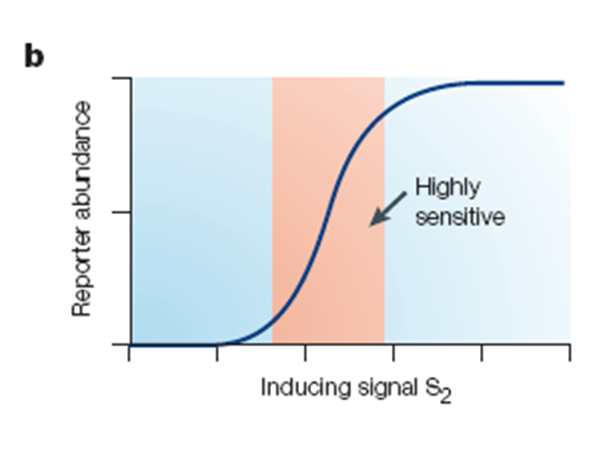Difference between revisions of "Noise in Synthetic Cascades"
| Line 4: | Line 4: | ||
Collins expressed that his colleague WJ Blake had engineered a transcriptional cascade composed of two regulatory steps. He found that increased noise in transcriptional regulatory signal increased population heterogenity very little at high or low levels of induction and was most sensitive during intermediate levels of induction. He commented that this fit his hypothesis becuase transcription rate is most sensitive to variation in regulatory signal at intermediate levels. The figure below illustrates this point as reporter abundance curve has the highest slope at intermediate levels of induction. | Collins expressed that his colleague WJ Blake had engineered a transcriptional cascade composed of two regulatory steps. He found that increased noise in transcriptional regulatory signal increased population heterogenity very little at high or low levels of induction and was most sensitive during intermediate levels of induction. He commented that this fit his hypothesis becuase transcription rate is most sensitive to variation in regulatory signal at intermediate levels. The figure below illustrates this point as reporter abundance curve has the highest slope at intermediate levels of induction. | ||
| − | + | <center> [[Image:Reporterabundacne.png]]</center> | |
<br><br><br> | <br><br><br> | ||
<center><b> [[Noise in Feedback Loops | Next Section in Manipulation of Stochasticity]] | [[Manipulation of Stochasticity | Return to Manipulation of Stochasticity]] </b></center> | <center><b> [[Noise in Feedback Loops | Next Section in Manipulation of Stochasticity]] | [[Manipulation of Stochasticity | Return to Manipulation of Stochasticity]] </b></center> | ||
Revision as of 03:50, 13 November 2007
HH McAdams and A Arkin characterized the noise propagation in synthetic cascades. He detailed that stochasticity in gene cascades lies in the time delay for protein accumulation. More specifically after the activation of a gene, to reach an effective level of control over the next gene requires a time for protein signals to acumulate. A threshold of protein control must be achieved in order for the sucessive protein to propagate its signal to the subsequent gene. Becuase proteins are produced in short bursts of variable numbers at random time intervals, there can be large differences in teh time between sucessive events in a regulatory cascade across a cell population.
The result of this heterogenity among genetic cascades can be a separation of the cell population into different phenotypes as the cell follow different paths.
Collins expressed that his colleague WJ Blake had engineered a transcriptional cascade composed of two regulatory steps. He found that increased noise in transcriptional regulatory signal increased population heterogenity very little at high or low levels of induction and was most sensitive during intermediate levels of induction. He commented that this fit his hypothesis becuase transcription rate is most sensitive to variation in regulatory signal at intermediate levels. The figure below illustrates this point as reporter abundance curve has the highest slope at intermediate levels of induction.
